Application of Ferrate as Coagulant and Oxidant Alternative for Purifying Saigon River Water
In this study, we aimed to use ferrate as an all-in-one alternative for the removal of
chlorine-consumed compositions such as organic, color, turbidity, iron, and manganese in river
water for water supply purposes. Ferrate (FeO42-) was simultaneously employed as coagulant and
oxidant for purification of Saigon River water in order to reduce the formation of disinfection byproducts in the produced tap water. The Jartest was conducted using both ferrate for raw river water
and poly-aluminum chloride (PAC) for chlorinated water to determine the optimum concentration
of chemicals and pH values as well as comparing the effectiveness of ferrate and traditional
coagulation with pre-chlorination technology for surface water purification. Results showed that
ferrate could be used to remove organic compounds with high efficiency of 86.2% at pH 5 - 6 and
ferrate concentration of 16 mgFe/L. Moreover, the removal efficiency for turbidity, color, and iron
were at least 90%, indicating that ferrate would be a very promising alternative for chlorine and
PAC for water purification
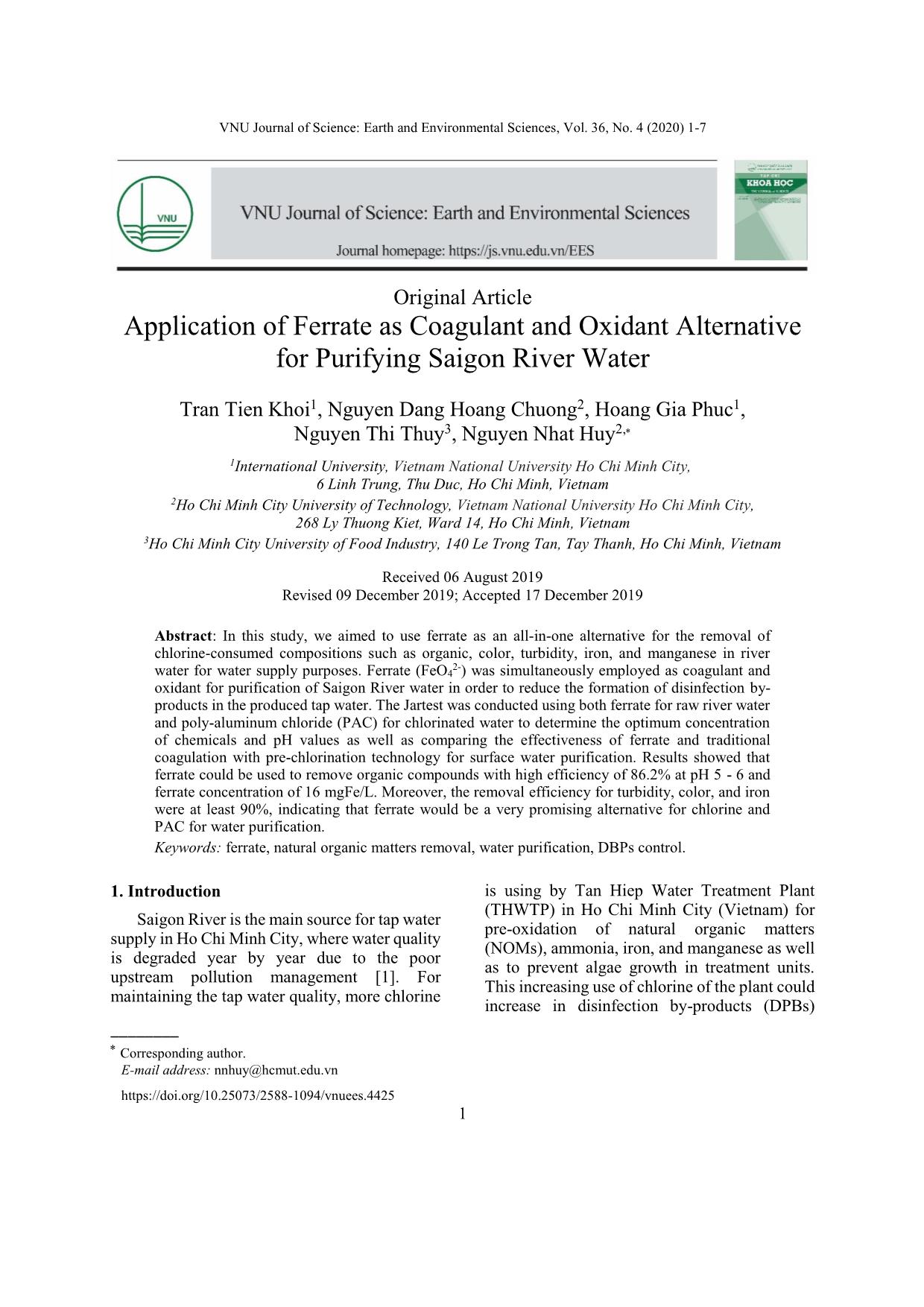
Trang 1
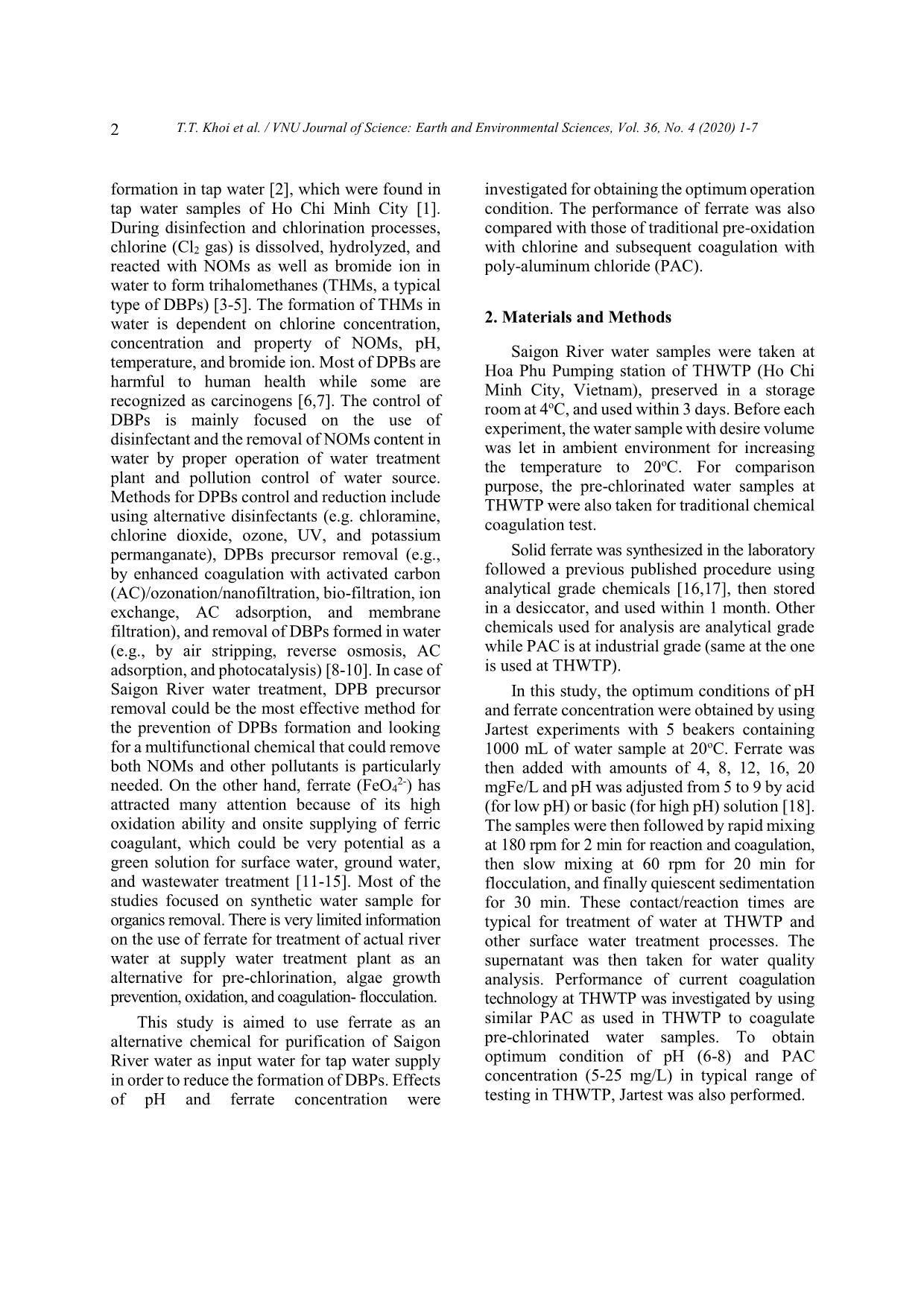
Trang 2
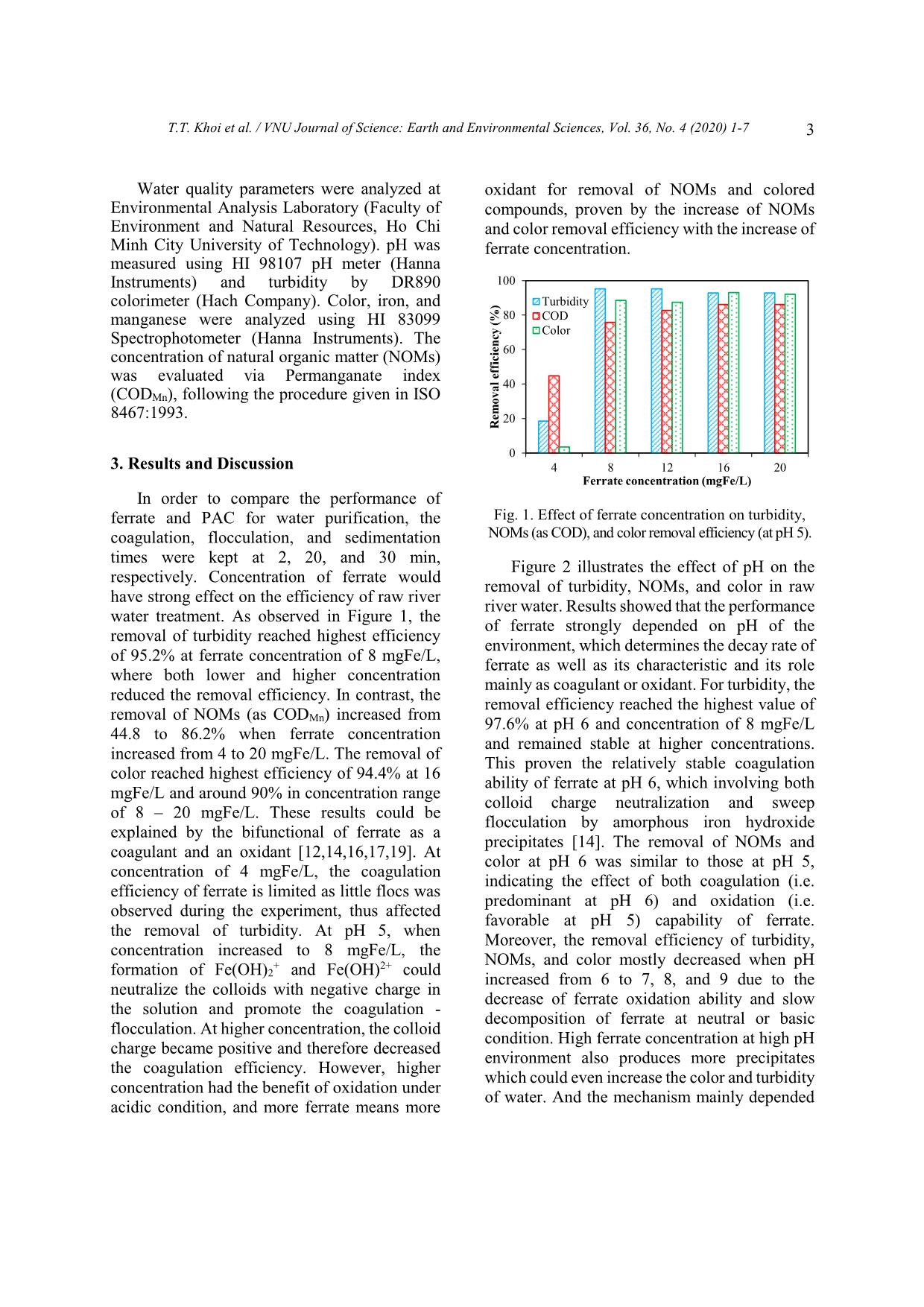
Trang 3
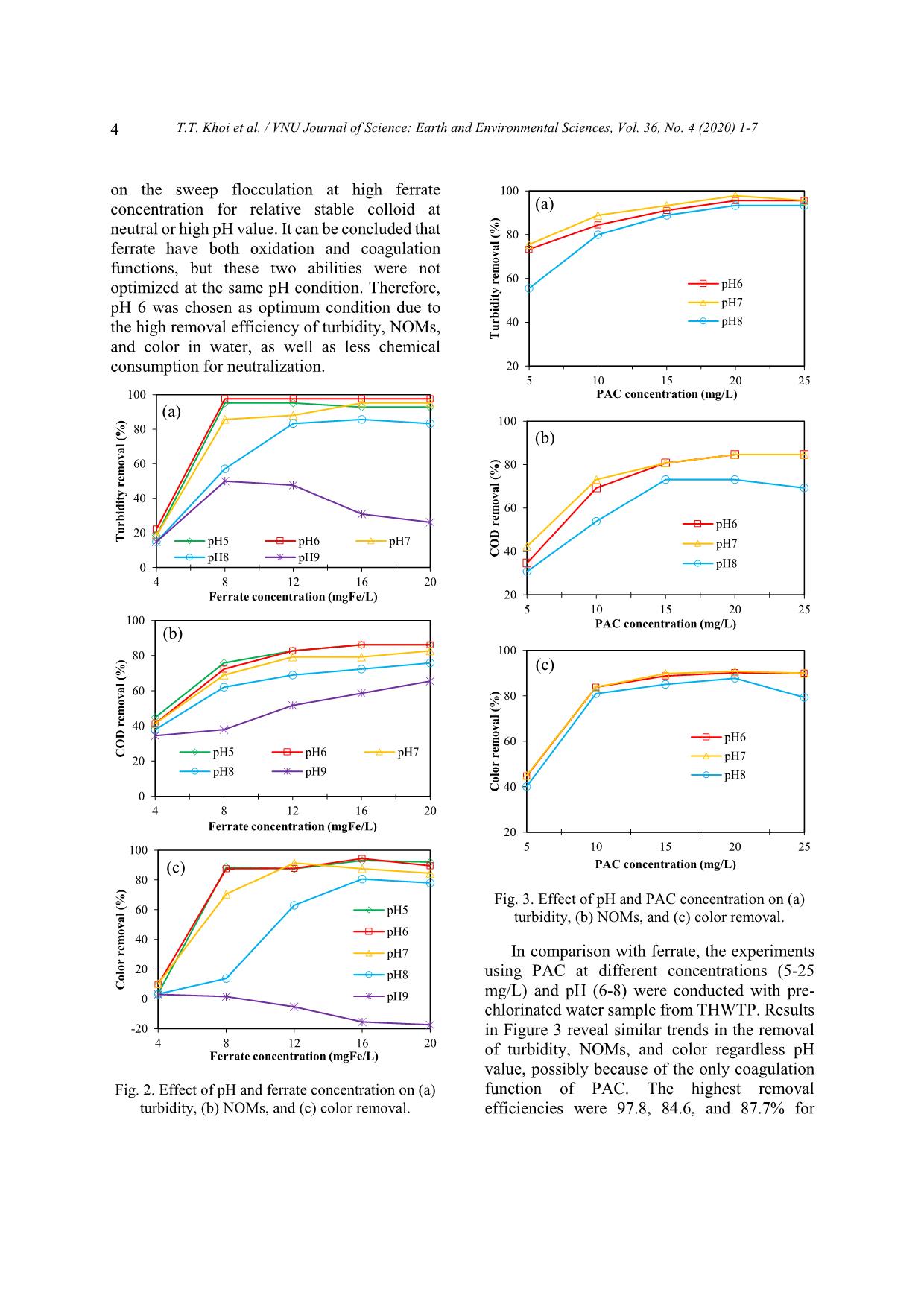
Trang 4
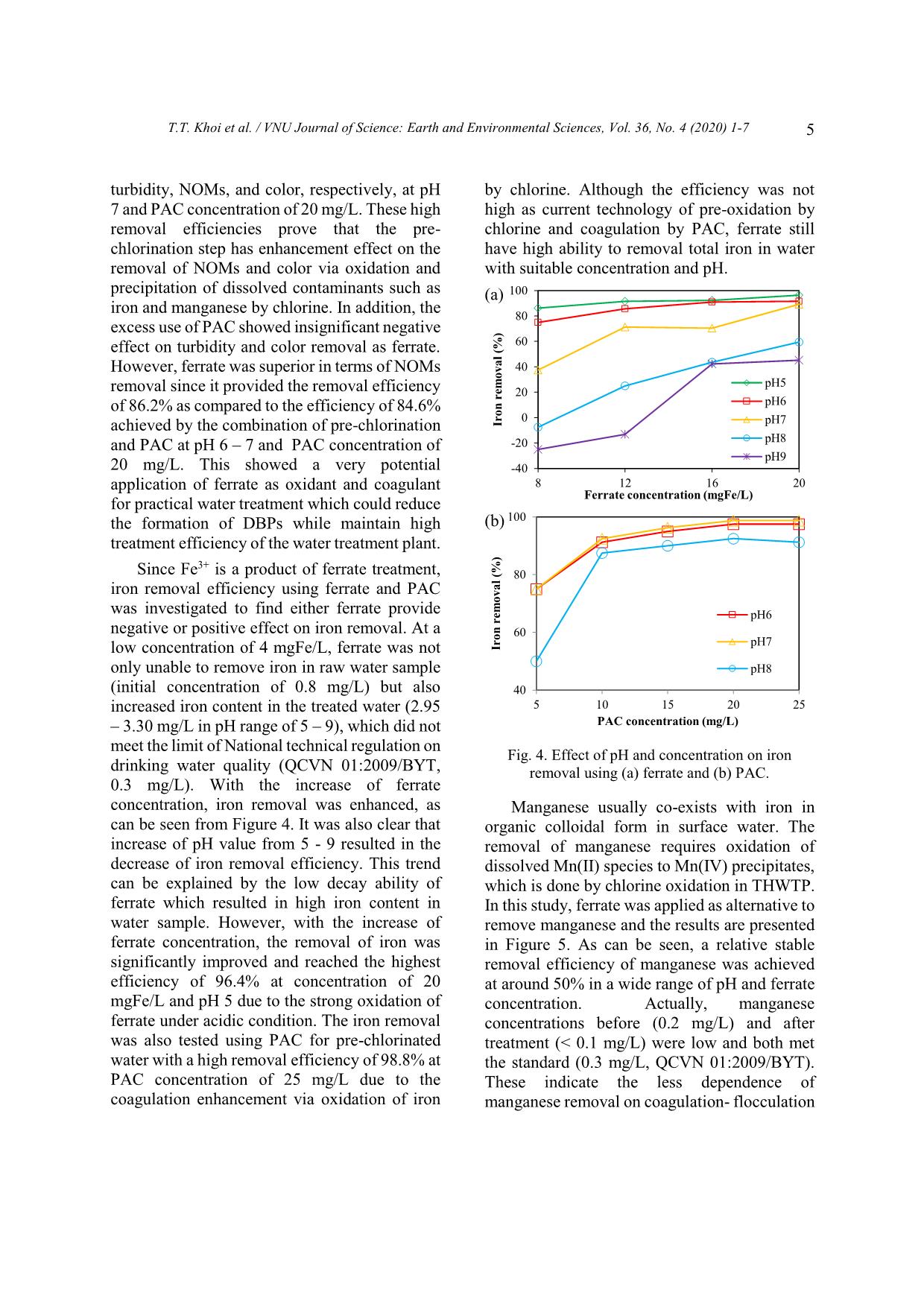
Trang 5
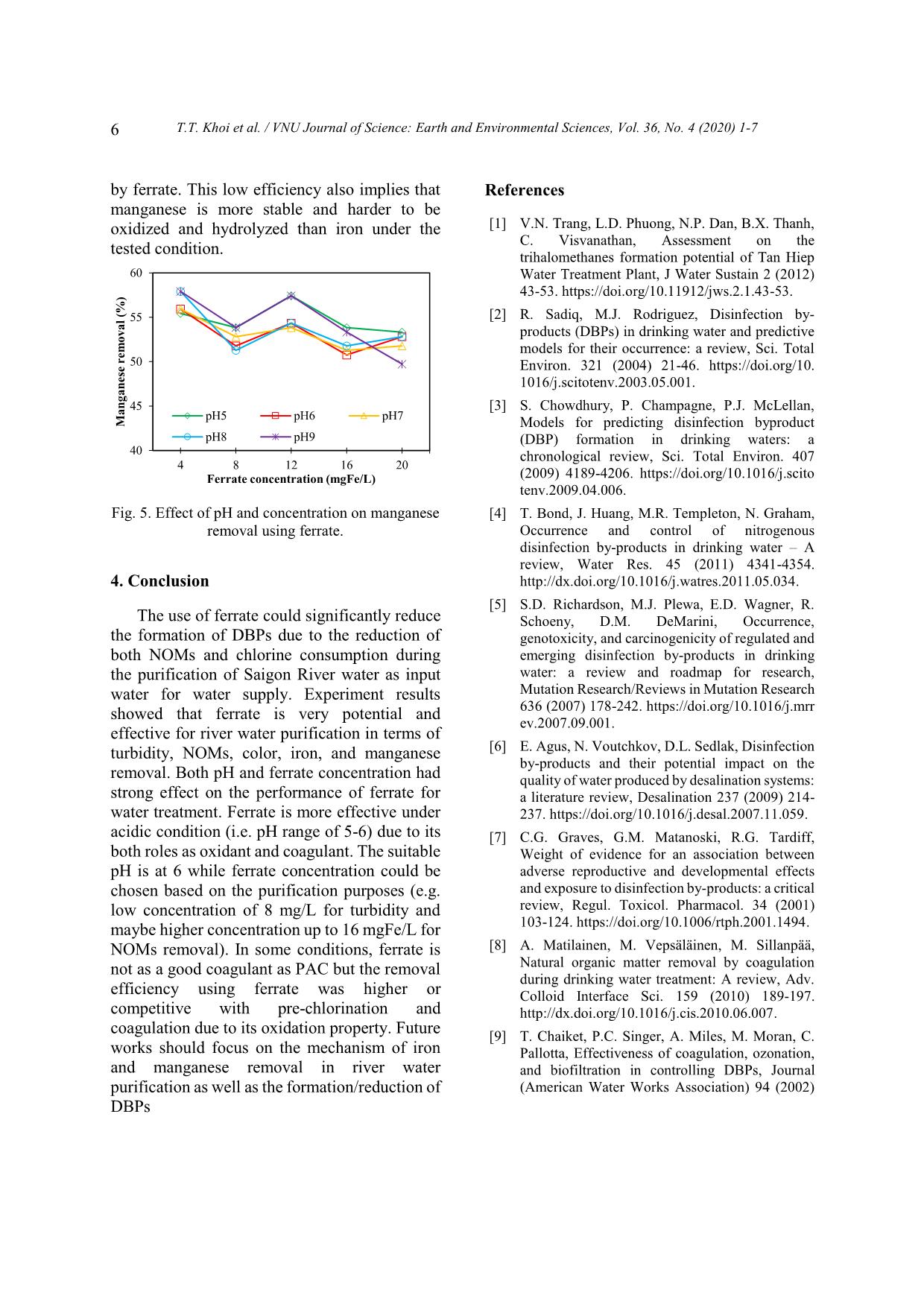
Trang 6
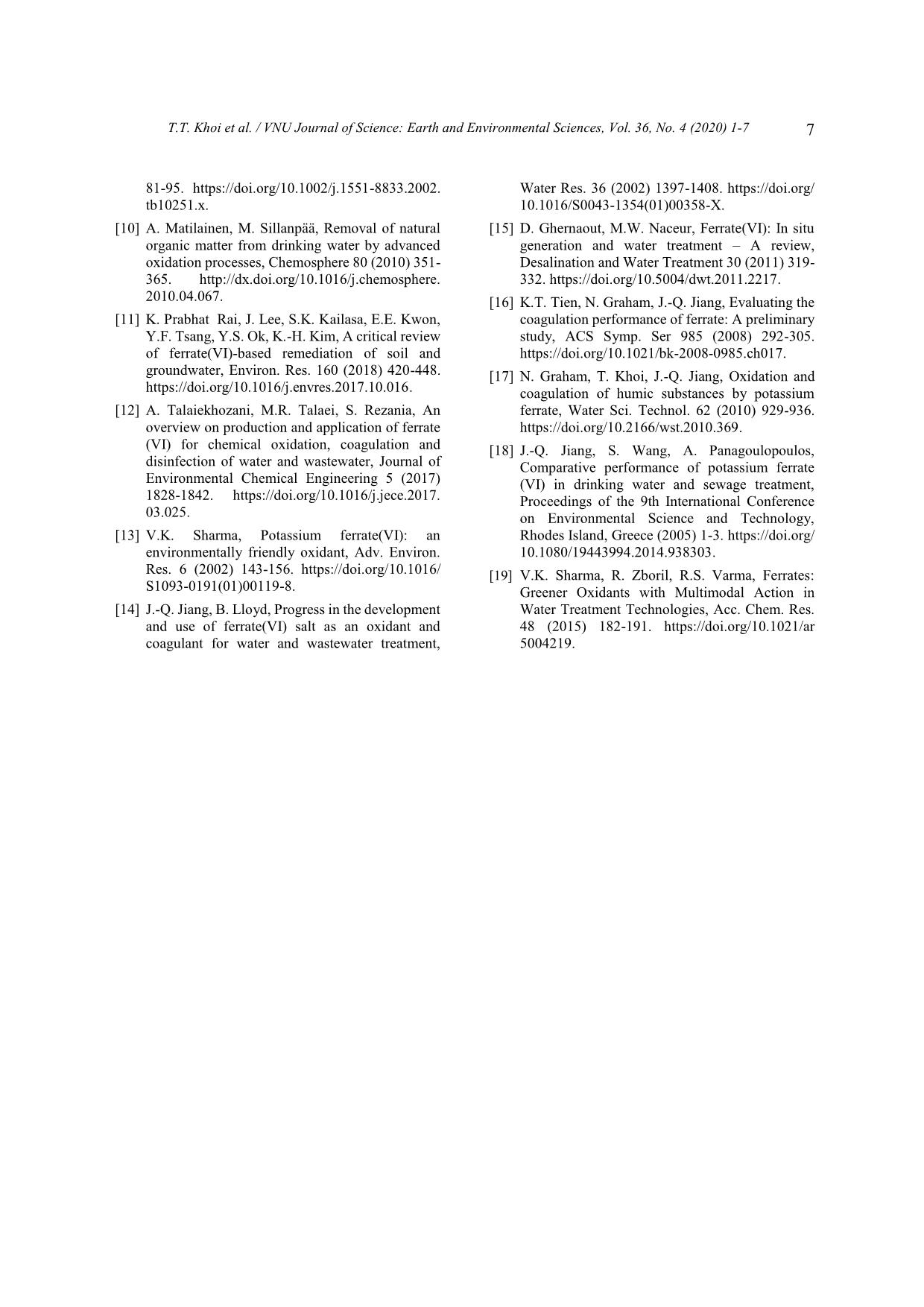
Trang 7
Tóm tắt nội dung tài liệu: Application of Ferrate as Coagulant and Oxidant Alternative for Purifying Saigon River Water

VNU Journal of Science: Earth and Environmental Sciences, Vol. 36, No. 4 (2020) 1-7 1 Original Article Application of Ferrate as Coagulant and Oxidant Alternative for Purifying Saigon River Water Tran Tien Khoi1, Nguyen Dang Hoang Chuong2, Hoang Gia Phuc1, Nguyen Thi Thuy3, Nguyen Nhat Huy2, 1International University, Vietnam National University Ho Chi Minh City, 6 Linh Trung, Thu Duc, Ho Chi Minh, Vietnam 2Ho Chi Minh City University of Technology, Vietnam National University Ho Chi Minh City, 268 Ly Thuong Kiet, Ward 14, Ho Chi Minh, Vietnam 3Ho Chi Minh City University of Food Industry, 140 Le Trong Tan, Tay Thanh, Ho Chi Minh, Vietnam Received 06 August 2019 Revised 09 December 2019; Accepted 17 December 2019 Abstract: In this study, we aimed to use ferrate as an all-in-one alternative for the removal of chlorine-consumed compositions such as organic, color, turbidity, iron, and manganese in river water for water supply purposes. Ferrate (FeO42-) was simultaneously employed as coagulant and oxidant for purification of Saigon River water in order to reduce the formation of disinfection by- products in the produced tap water. The Jartest was conducted using both ferrate for raw river water and poly-aluminum chloride (PAC) for chlorinated water to determine the optimum concentration of chemicals and pH values as well as comparing the effectiveness of ferrate and traditional coagulation with pre-chlorination technology for surface water purification. Results showed that ferrate could be used to remove organic compounds with high efficiency of 86.2% at pH 5 - 6 and ferrate concentration of 16 mgFe/L. Moreover, the removal efficiency for turbidity, color, and iron were at least 90%, indicating that ferrate would be a very promising alternative for chlorine and PAC for water purification. Keywords: ferrate, natural organic matters removal, water purification, DBPs control. 1. Introduction Saigon River is the main source for tap water supply in Ho Chi Minh City, where water quality is degraded year by year due to the poor upstream pollution management [1]. For maintaining the tap water quality, more chlorine ________ Corresponding author. E-mail address: nnhuy@hcmut.edu.vn https://doi.org/10.25073/2588-1094/vnuees.4425 is using by Tan Hiep Water Treatment Plant (THWTP) in Ho Chi Minh City (Vietnam) for pre-oxidation of natural organic matters (NOMs), ammonia, iron, and manganese as well as to prevent algae growth in treatment units. This increasing use of chlorine of the plant could increase in disinfection by-products (DPBs) T.T. Khoi et al. / VNU Journal of Science: Earth and Environmental Sciences, Vol. 36, No. 4 (2020) 1-7 2 formation in tap water [2], which were found in tap water samples of Ho Chi Minh City [1]. During disinfection and chlorination processes, chlorine (Cl2 gas) is dissolved, hydrolyzed, and reacted with NOMs as well as bromide ion in water to form trihalomethanes (THMs, a typical type of DBPs) [3-5]. The formation of THMs in water is dependent on chlorine concentration, concentration and property of NOMs, pH, temperature, and bromide ion. Most of DPBs are harmful to human health while some are recognized as carcinogens [6,7]. The control of DBPs is mainly focused on the use of disinfectant and the removal of NOMs content in water by proper operation of water treatment plant and pollution control of water source. Methods for DPBs control and reduction include using alternative disinfectants (e.g. chloramine, chlorine dioxide, ozone, UV, and potassium permanganate), DPBs precursor removal (e.g., by enhanced coagulation with activated carbon (AC)/ozonation/nanofiltration, bio-filtration, ion exchange, AC adsorption, and membrane filtration), and removal of DBPs formed in water (e.g., by air stripping, reverse osmosis, AC adsorption, and photocatalysis) [8-10]. In case of Saigon River water treatment, DPB precursor removal could be the most effective method for the prevention of DPBs formation and looking for a multifunctional chemical that could remove both NOMs and other pollutants is particularly needed. On the other hand, ferrate (FeO42-) has attracted many attention because of its high oxidation ability and onsite supplying of ferric coagulant, which could be very potential as a green solution for surface water, ground water, and wastewater treatment [11-15]. Most of the studies focused on synthetic water sample for organics removal. There is very limited information on the use of ferrate for treatment of actual river water at supply water treatment plant as an alternative for pre-chlorination, algae growth prevention, oxidation, and coagulation- flocculation. This study is aimed to use ferrate as an alternative chemical for purification of Saigon River water as input water for tap water supply in order to reduce the formation of DBPs. Effects of pH and ferrate concentration were investigated for obtaining the optimum operation condition. The performance of ferrate was also compared with those of traditional pre-oxidation with chlorine and subsequent coagulation with poly-aluminum chloride (PAC). 2. Materials and Methods Saigon River water samples were taken at Hoa Phu Pumping station of THWTP (Ho Chi Minh City, Vietnam), preserved in a storage room at 4oC, and used within 3 days. Before each experiment, the water sample with desire volume was let in ambient environment for increasing the temperature to 20oC. For comparison purpose, the pre-chlorinated water samples at THWTP were also taken for traditional chemical coagulation test. Solid ferrate was synthesized in the laboratory followed a previous published procedure using analytical grade chemicals [16,17], then stored in a desiccator, and used within 1 month. Other chemicals used for analys ... d the coagulation efficiency. However, higher concentration had the benefit of oxidation under acidic condition, and more ferrate means more oxidant for removal of NOMs and colored compounds, proven by the increase of NOMs and color removal efficiency with the increase of ferrate concentration. Fig. 1. Effect of ferrate concentration on turbidity, NOMs (as COD), and color removal efficiency (at pH 5). Figure 2 illustrates the effect of pH on the removal of turbidity, NOMs, and color in raw river water. Results showed that the performance of ferrate strongly depended on pH of the environment, which determines the decay rate of ferrate as well as its characteristic and its role mainly as coagulant or oxidant. For turbidity, the removal efficiency reached the highest value of 97.6% at pH 6 and concentration of 8 mgFe/L and remained stable at higher concentrations. This proven the relatively stable coagulation ability of ferrate at pH 6, which involving both colloid charge neutralization and sweep flocculation by amorphous iron hydroxide precipitates [14]. The removal of NOMs and color at pH 6 was similar to those at pH 5, indicating the effect of both coagulation (i.e. predominant at pH 6) and oxidation (i.e. favorable at pH 5) capability of ferrate. Moreover, the removal efficiency of turbidity, NOMs, and color mostly decreased when pH increased from 6 to 7, 8, and 9 due to the decrease of ferrate oxidation ability and slow decomposition of ferrate at neutral or basic condition. High ferrate concentration at high pH environment also produces more precipitates which could even increase the color and turbidity of water. And the mechanism mainly depended 0 20 40 60 80 100 4 8 12 16 20 R e m o v a l e ff ic ie n cy ( % ) Ferrate concentration (mgFe/L) Turbidity COD Color T.T. Khoi et al. / VNU Journal of Science: Earth and Environmental Sciences, Vol. 36, No. 4 (2020) 1-7 4 on the sweep flocculation at high ferrate concentration for relative stable colloid at neutral or high pH value. It can be concluded that ferrate have both oxidation and coagulation functions, but these two abilities were not optimized at the same pH condition. Therefore, pH 6 was chosen as optimum condition due to the high removal efficiency of turbidity, NOMs, and color in water, as well as less chemical consumption for neutralization. Fig. 2. Effect of pH and ferrate concentration on (a) turbidity, (b) NOMs, and (c) color removal. Fig. 3. Effect of pH and PAC concentration on (a) turbidity, (b) NOMs, and (c) color removal. In comparison with ferrate, the experiments using PAC at different concentrations (5-25 mg/L) and pH (6-8) were conducted with pre- chlorinated water sample from THWTP. Results in Figure 3 reveal similar trends in the removal of turbidity, NOMs, and color regardless pH value, possibly because of the only coagulation function of PAC. The highest removal efficiencies were 97.8, 84.6, and 87.7% for 0 20 40 60 80 100 4 8 12 16 20 T u r b id it y r e m o v a l (% ) Ferrate concentration (mgFe/L) pH5 pH6 pH7 pH8 pH9 (a) 0 20 40 60 80 100 4 8 12 16 20 C O D r e m o v a l (% ) Ferrate concentration (mgFe/L) pH5 pH6 pH7 pH8 pH9 (b) -20 0 20 40 60 80 100 4 8 12 16 20 C o lo r r e m o v a l (% ) Ferrate concentration (mgFe/L) pH5 pH6 pH7 pH8 pH9 (c) 20 40 60 80 100 5 10 15 20 25 T u r b id it y r e m o v a l (% ) PAC concentration (mg/L) pH6 pH7 pH8 (a) 20 40 60 80 100 5 10 15 20 25 C O D r e m o v a l (% ) PAC concentration (mg/L) pH6 pH7 pH8 (b) 20 40 60 80 100 5 10 15 20 25 C o lo r r e m o v a l (% ) PAC concentration (mg/L) pH6 pH7 pH8 (c) T.T. Khoi et al. / VNU Journal of Science: Earth and Environmental Sciences, Vol. 36, No. 4 (2020) 1-7 5 turbidity, NOMs, and color, respectively, at pH 7 and PAC concentration of 20 mg/L. These high removal efficiencies prove that the pre- chlorination step has enhancement effect on the removal of NOMs and color via oxidation and precipitation of dissolved contaminants such as iron and manganese by chlorine. In addition, the excess use of PAC showed insignificant negative effect on turbidity and color removal as ferrate. However, ferrate was superior in terms of NOMs removal since it provided the removal efficiency of 86.2% as compared to the efficiency of 84.6% achieved by the combination of pre-chlorination and PAC at pH 6 – 7 and PAC concentration of 20 mg/L. This showed a very potential application of ferrate as oxidant and coagulant for practical water treatment which could reduce the formation of DBPs while maintain high treatment efficiency of the water treatment plant. Since Fe3+ is a product of ferrate treatment, iron removal efficiency using ferrate and PAC was investigated to find either ferrate provide negative or positive effect on iron removal. At a low concentration of 4 mgFe/L, ferrate was not only unable to remove iron in raw water sample (initial concentration of 0.8 mg/L) but also increased iron content in the treated water (2.95 – 3.30 mg/L in pH range of 5 – 9), which did not meet the limit of National technical regulation on drinking water quality (QCVN 01:2009/BYT, 0.3 mg/L). With the increase of ferrate concentration, iron removal was enhanced, as can be seen from Figure 4. It was also clear that increase of pH value from 5 - 9 resulted in the decrease of iron removal efficiency. This trend can be explained by the low decay ability of ferrate which resulted in high iron content in water sample. However, with the increase of ferrate concentration, the removal of iron was significantly improved and reached the highest efficiency of 96.4% at concentration of 20 mgFe/L and pH 5 due to the strong oxidation of ferrate under acidic condition. The iron removal was also tested using PAC for pre-chlorinated water with a high removal efficiency of 98.8% at PAC concentration of 25 mg/L due to the coagulation enhancement via oxidation of iron by chlorine. Although the efficiency was not high as current technology of pre-oxidation by chlorine and coagulation by PAC, ferrate still have high ability to removal total iron in water with suitable concentration and pH. Fig. 4. Effect of pH and concentration on iron removal using (a) ferrate and (b) PAC. Manganese usually co-exists with iron in organic colloidal form in surface water. The removal of manganese requires oxidation of dissolved Mn(II) species to Mn(IV) precipitates, which is done by chlorine oxidation in THWTP. In this study, ferrate was applied as alternative to remove manganese and the results are presented in Figure 5. As can be seen, a relative stable removal efficiency of manganese was achieved at around 50% in a wide range of pH and ferrate concentration. Actually, manganese concentrations before (0.2 mg/L) and after treatment (< 0.1 mg/L) were low and both met the standard (0.3 mg/L, QCVN 01:2009/BYT). These indicate the less dependence of manganese removal on coagulation- flocculation -40 -20 0 20 40 60 80 100 8 12 16 20 Ir o n r e m o v a l (% ) Ferrate concentration (mgFe/L) pH5 pH6 pH7 pH8 pH9 (a) 40 60 80 100 5 10 15 20 25 Ir o n r e m o v a l (% ) PAC concentration (mg/L) pH6 pH7 pH8 (b) T.T. Khoi et al. / VNU Journal of Science: Earth and Environmental Sciences, Vol. 36, No. 4 (2020) 1-7 6 by ferrate. This low efficiency also implies that manganese is more stable and harder to be oxidized and hydrolyzed than iron under the tested condition. Fig. 5. Effect of pH and concentration on manganese removal using ferrate. 4. Conclusion The use of ferrate could significantly reduce the formation of DBPs due to the reduction of both NOMs and chlorine consumption during the purification of Saigon River water as input water for water supply. Experiment results showed that ferrate is very potential and effective for river water purification in terms of turbidity, NOMs, color, iron, and manganese removal. Both pH and ferrate concentration had strong effect on the performance of ferrate for water treatment. Ferrate is more effective under acidic condition (i.e. pH range of 5-6) due to its both roles as oxidant and coagulant. The suitable pH is at 6 while ferrate concentration could be chosen based on the purification purposes (e.g. low concentration of 8 mg/L for turbidity and maybe higher concentration up to 16 mgFe/L for NOMs removal). In some conditions, ferrate is not as a good coagulant as PAC but the removal efficiency using ferrate was higher or competitive with pre-chlorination and coagulation due to its oxidation property. Future works should focus on the mechanism of iron and manganese removal in river water purification as well as the formation/reduction of DBPs References [1] V.N. Trang, L.D. Phuong, N.P. Dan, B.X. Thanh, C. Visvanathan, Assessment on the trihalomethanes formation potential of Tan Hiep Water Treatment Plant, J Water Sustain 2 (2012) 43-53. https://doi.org/10.11912/jws.2.1.43-53. [2] R. Sadiq, M.J. Rodriguez, Disinfection by- products (DBPs) in drinking water and predictive models for their occurrence: a review, Sci. Total Environ. 321 (2004) 21-46. https://doi.org/10. 1016/j.scitotenv.2003.05.001. [3] S. Chowdhury, P. Champagne, P.J. McLellan, Models for predicting disinfection byproduct (DBP) formation in drinking waters: a chronological review, Sci. Total Environ. 407 (2009) 4189-4206. https://doi.org/10.1016/j.scito tenv.2009.04.006. [4] T. Bond, J. Huang, M.R. Templeton, N. Graham, Occurrence and control of nitrogenous disinfection by-products in drinking water – A review, Water Res. 45 (2011) 4341-4354. [5] S.D. Richardson, M.J. Plewa, E.D. Wagner, R. Schoeny, D.M. DeMarini, Occurrence, genotoxicity, and carcinogenicity of regulated and emerging disinfection by-products in drinking water: a review and roadmap for research, Mutation Research/Reviews in Mutation Research 636 (2007) 178-242. https://doi.org/10.1016/j.mrr ev.2007.09.001. [6] E. Agus, N. Voutchkov, D.L. Sedlak, Disinfection by-products and their potential impact on the quality of water produced by desalination systems: a literature review, Desalination 237 (2009) 214- 237. https://doi.org/10.1016/j.desal.2007.11.059. [7] C.G. Graves, G.M. Matanoski, R.G. Tardiff, Weight of evidence for an association between adverse reproductive and developmental effects and exposure to disinfection by-products: a critical review, Regul. Toxicol. Pharmacol. 34 (2001) 103-124. https://doi.org/10.1006/rtph.2001.1494. [8] A. Matilainen, M. Vepsäläinen, M. Sillanpää, Natural organic matter removal by coagulation during drinking water treatment: A review, Adv. Colloid Interface Sci. 159 (2010) 189-197. [9] T. Chaiket, P.C. Singer, A. Miles, M. Moran, C. Pallotta, Effectiveness of coagulation, ozonation, and biofiltration in controlling DBPs, Journal (American Water Works Association) 94 (2002) 40 45 50 55 60 4 8 12 16 20 M a n g a n e se r e m o v a l (% ) Ferrate concentration (mgFe/L) pH5 pH6 pH7 pH8 pH9 T.T. Khoi et al. / VNU Journal of Science: Earth and Environmental Sciences, Vol. 36, No. 4 (2020) 1-7 7 81-95. https://doi.org/10.1002/j.1551-8833.2002. tb10251.x. [10] A. Matilainen, M. Sillanpää, Removal of natural organic matter from drinking water by advanced oxidation processes, Chemosphere 80 (2010) 351- 365. 2010.04.067. [11] K. Prabhat Rai, J. Lee, S.K. Kailasa, E.E. Kwon, Y.F. Tsang, Y.S. Ok, K.-H. Kim, A critical review of ferrate(VI)-based remediation of soil and groundwater, Environ. Res. 160 (2018) 420-448. https://doi.org/10.1016/j.envres.2017.10.016. [12] A. Talaiekhozani, M.R. Talaei, S. Rezania, An overview on production and application of ferrate (VI) for chemical oxidation, coagulation and disinfection of water and wastewater, Journal of Environmental Chemical Engineering 5 (2017) 1828-1842. https://doi.org/10.1016/j.jece.2017. 03.025. [13] V.K. Sharma, Potassium ferrate(VI): an environmentally friendly oxidant, Adv. Environ. Res. 6 (2002) 143-156. https://doi.org/10.1016/ S1093-0191(01)00119-8. [14] J.-Q. Jiang, B. Lloyd, Progress in the development and use of ferrate(VI) salt as an oxidant and coagulant for water and wastewater treatment, Water Res. 36 (2002) 1397-1408. https://doi.org/ 10.1016/S0043-1354(01)00358-X. [15] D. Ghernaout, M.W. Naceur, Ferrate(VI): In situ generation and water treatment – A review, Desalination and Water Treatment 30 (2011) 319- 332. https://doi.org/10.5004/dwt.2011.2217. [16] K.T. Tien, N. Graham, J.-Q. Jiang, Evaluating the coagulation performance of ferrate: A preliminary study, ACS Symp. Ser 985 (2008) 292-305. https://doi.org/10.1021/bk-2008-0985.ch017. [17] N. Graham, T. Khoi, J.-Q. Jiang, Oxidation and coagulation of humic substances by potassium ferrate, Water Sci. Technol. 62 (2010) 929-936. https://doi.org/10.2166/wst.2010.369. [18] J.-Q. Jiang, S. Wang, A. Panagoulopoulos, Comparative performance of potassium ferrate (VI) in drinking water and sewage treatment, Proceedings of the 9th International Conference on Environmental Science and Technology, Rhodes Island, Greece (2005) 1-3. https://doi.org/ 10.1080/19443994.2014.938303. [19] V.K. Sharma, R. Zboril, R.S. Varma, Ferrates: Greener Oxidants with Multimodal Action in Water Treatment Technologies, Acc. Chem. Res. 48 (2015) 182-191. https://doi.org/10.1021/ar 5004219.
File đính kèm:
 application_of_ferrate_as_coagulant_and_oxidant_alternative.pdf
application_of_ferrate_as_coagulant_and_oxidant_alternative.pdf

